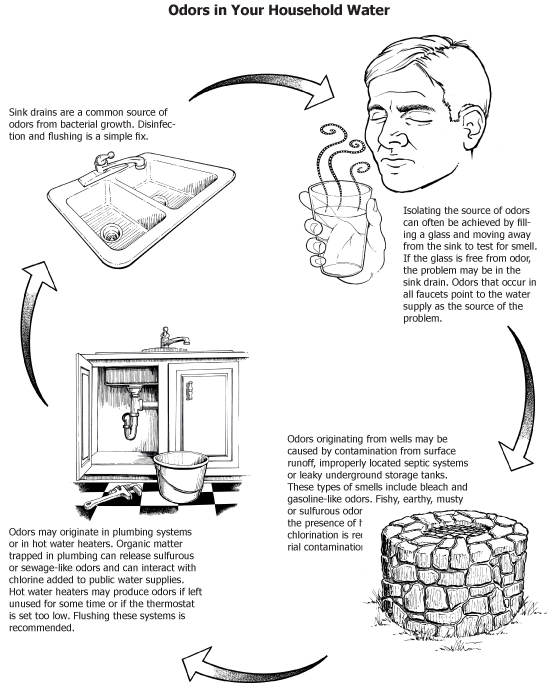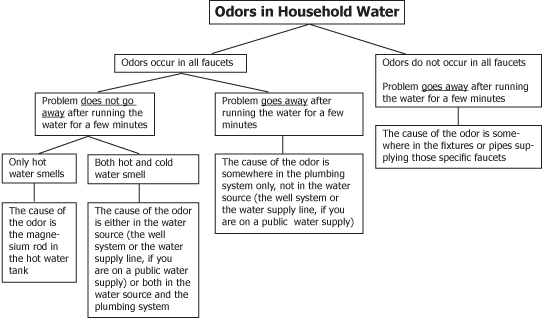Why Does Paint Smell Like Dirty Socks
Uttam Saha, Leticia Sonon, Jake Mowrer and David Kissel
UGA Agricultural and Environmental Services Laboratories
- Locating the Source of the Odor
- Drinking Water: Common odor problems, probable causes and suggested corrective measures
- References
Homeowners sometimes experience unpleasant odors in their household water. In many cases, the exact cause of the odor is difficult to determine by water testing; however, this publication provides a few general recommendations for treating some common causes of household water odors.

Locating the Source of the Odor
If odor occurs in all water faucets, the problem is probably in the main water supply. If it occurs only in certain faucets, the problem is likely in the fixtures or pipes supplying those specific faucets. If the problem goes away after running the water for a few minutes, the problem is somewhere in the household plumbing system. If the odor is persistent, the problem could be the water source or a combination of both the water source and the plumbing system. Figure 1 outlines the possible sources of odors in water.

For odors coming from the plumbing system or the well system, corrective measures are suggested. If you obtain water from a public water supply (PWS) and the odor is suspected to originate from the water source line, contact your water provider. This is especially true if your neighbors also experience the same type of odor problem.
Drinking Water: Common odor problems, probable causes and suggested corrective measures
If a particular odor problem in your household water and its cause are not included in this list, discuss the problem with a drinking water professional from your water provider (if you are on a public water supply), county health department or UGA Cooperative Extension agent (1-800-ASK-UGA-1).
a. Bleach, Chemical or Medicinal Odor
Public water suppliers generally chlorinate water to prevent bacterial growth. Typical levels of free chlorine in drinking water from PWS are 0.2 - 2.0 parts per million (ppm), though levels can be as high as 5.0 ppm. Odors resulting from a chlorine addition usually go away if the water is exposed to air for several minutes.
Adding chlorine to the water through shock chlorination of a well or plumbing system produces a strong bleach (chlorine) odor. The bleach smell stops when chlorine completely dissipates. This requires turning on outside faucets and letting the water run until the smell is gone.
In some cases, the added chlorine may interact with organic materials built up in the plumbing system and add odor to the water. The odor should disappear after running the water for a few minutes. Use Figure 1 to locate the source of the odor. If water is supplied by your own well and the problem appears to be in your plumbing and/or well systems, then your entire water system should be flushed, preferably by a licensed well driller or pump installer. If you are on a PWS and the problem appears to be the water supply line, contact your water supply authority.
b. Rotten Eggs (Sulfurous), Decayed or Sewage-like Odor
Generally, a rotten egg (or sulfurous), decayed or sewage-like odor in household water is a result of bacterial activity, which can be due to:
- Bacteria growing in the drain: This is the most common cause of these types of odors. Over time, organic matter such as hair, soap and food waste can accumulate on the walls of the drain. These deposits serve as a food for bacteria to grow. The bacteria can produce a gas that smells like rotten eggs or sewage. Address this problem by following these two steps:
- First, ensure that both the cold and hot water have the smell and that the smell is coming out of one or several faucets, but not all. Fill a glass with water from the sink that has the smell, then step away from the sink and swirl the water around inside the glass few times. If the problem is in the drain, the tap water in the glass should not have an odor.
- If the water in the glass does not smell, you should disinfect and flush the drain.
- Bacteria growing in the water heater: Bacteria growing in the water heater can also produce a rotten egg or sewage smell. Frequently, this occurs if the hot water is unused, if the water heater is turned off for a significant period of time or if the thermostat on the heater is set too low. Generally, the bacteria that produce this problem are not a health threat; however, the taste and odor can be very unpleasant. To address this problem, the following actions are suggested:
- Make sure that hot water smells, but cold water does not. Often, the smell originates from a magnesium heating rod in the hot water tank.
- If the heater has a magnesium rod, a licensed plumber can replace it with an acceptable alternative such as an aluminum rod.
- Bacteria growing in the well: If problems with the drain or water heater are ruled out, the odor may be coming from the water source. Do not use the water because it may contain harmful bacteria. To address this problem, the following actions are suggested:
- If you are on your own well, the natural groundwater chemistry may be supporting bacterial growth in the well. Shock chlorinate the well and pump out water until the chlorine odor disappears. For a step-by-step shock chlorination procedure, refer to the University of Georgia publication "Disinfecting Your Well Water: Shock Chlorination."
- A defective or improperly located septic system may be present near your well. Contact your county health department.
- If you are on a PWS, contact your water supply authority or county health department immediately.
For more information about rotten egg odor, refer to the University of Georgia publication "Your Household Water Quality: Hydrogen Sulfide and Sulfate."
c. Musty, Moldy, Earthy, Grassy or Fishy Odor
Although these odors are harmless, the human senses of taste and smell are extremely sensitive even at a very low level. These kinds of odors may be due to:
- Decaying organic matter in the drain
- Pollution of well water from surface drainage
The presence of bacteria is very common in both cases. By far, the most common cause of this type of problem is the decaying organic matter deposited over time in the drain. To make sure the problem is not in the well, fill a glass with tap water, then step away from the sink and swirl the water around inside the glass few times. If the problem is in the drain, the tap water in the glass should not have an odor. Disinfecting, cleaning and flushing the drain should eliminate the odor.
The reservoir/pressure tank may also be the source of such an odor. Cleaning and maintaining the reservoir/ pressure tank periodically can prevent bacteria from growing to levels that cause odor in the water. Less commonly, certain types of algae, fungi and bacteria growing in the water supply, especially during warm weather, can affect the water odor.
If the problem is in the well, shock chlorinate the well and pump out plenty of water until the smell of chlorine disappears. If the problem persists, consider installing:
- An activated carbon filter OR
- An automatic chlorinator followed by an activated carbon filter.
If you are on a PWS and insufficient chlorine is being used to disinfect the water, certain types of bacteria may grow in the supply line and cause these kinds of odors. Contact your water supply authority or county health department.
d. Petroleum, Gasoline, Turpentine, Fuel-like or Solvent-like Odor
Even though these odor problems are rare, they are potentially serious. These odors may be due to:
- A leaking fuel tank or underground fuel storage tank near your well
- Discharge from factories or landfills contaminating the water supply
- Run-off from agriculture contaminating the water supply
Stop drinking the water because it may cause several adverse health consequences, including but not limited to:
- Anemia
- Increased risk of cancer
- Liver and kidney problems
Remedial actions include:
- Report the problem to your county health department
- Eliminate the source of the problem
- Install an activated carbon filtration system after determining the type and source of the chemical contaminant
If you are on a PWS, contact your water supply authority and county health department immediately.
e. Other Odors
| Odor | Probable Cause | Possible Health Effects | Suggested Remedies |
| Detergent odor or foaming water |
|
|
|
| Methane gas odor |
|
|
|
| Sharp chemical odor |
|
|
|
References
Color, Taste, and Odor Problems in Drinking Water. Fact Sheet. Washington Department of Health, January, 2011. http://www.doh.wa.gov/portals/1/Documents/pubs/331-286.pdf
Color, Taste, and Odor: What you should know. Massachusetts Department of Environmental Protection. http://www.mass.gov/dep/water/drinking/color.htm
Liukkonen, B. 2011. Why Well Water Smells Bad. University of Minnesota Extension. http://www.extension.umn.edu/environment/housing-technology/moisture-management/why-water-smells-bad/.
Saha, U., L. Sonon, M. Risse and D. Kissel. 2011. Water Quality and Common Treatments for Private Drinking Water Systems. Bulletin 939 (Revised July 2011). University of Georgia Cooperative Extension. https://extension.uga.edu/publications/detail.html?number=B939
World Health Organization. 2008. Guidelines for Drinking-water Quality. Chapter 10. Acceptability Aspects: Taste, Odor and Appearance. WHO Press, World Health Organization, Geneva, Switzerland.
Reviewers: Mark Risse and William Carlan, University of Georgia; Kristine Uhlman, Texas A&M University; Beth Thomas, AdEdge Water Technologies, Inc.
Status and Revision History
Published on May 15, 2012
Published with Full Review on Mar 28, 2017
Published with Full Review on Sep 13, 2021
Why Does Paint Smell Like Dirty Socks
Source: https://extension.uga.edu/publications/detail.html?number=C1016&title=Your+Household+Water+Quality%3A+Odors+in+Your+Water